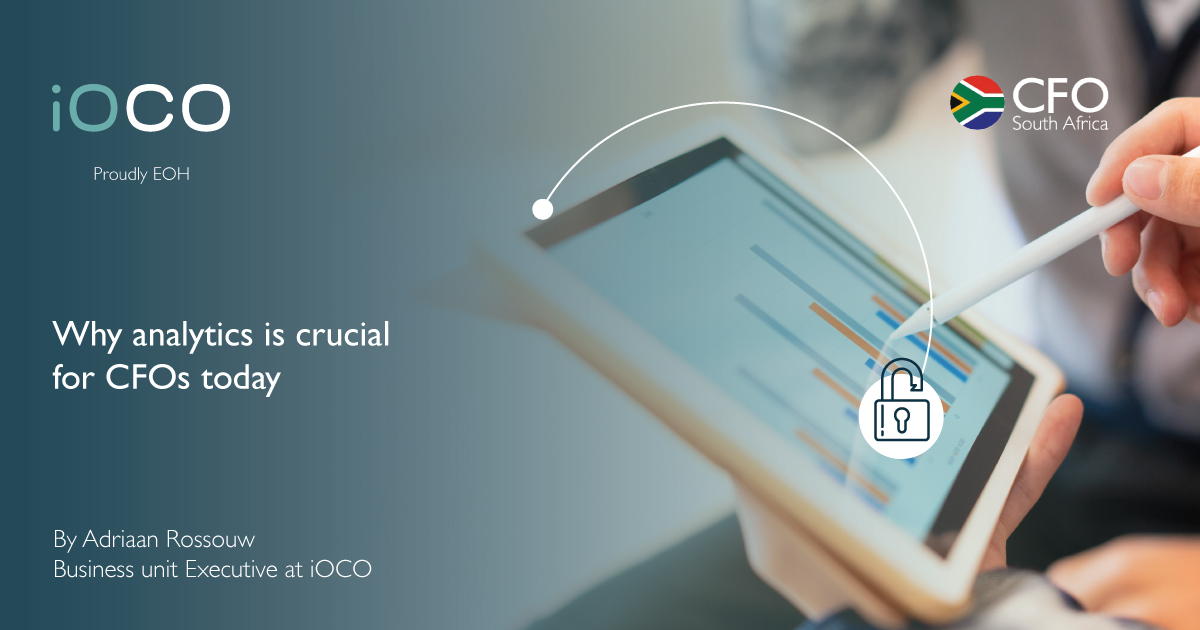iOCO’s Adriaan Rossouw reveals how analytics helps CFOs tackle assumptions and move on business moments.
Over the past three years, business and financial leaders have learned that the concept of business as usual doesn’t exist anymore. There’s too much change, taking place too rapidly, for CFOs and their businesses to rely on traditional and outdated methods of reporting, analysis and forecasting for quick decision-making.
When things aren’t going well, financial and business managers have more questions than ever, and they need the information to not only answer question one, but subsequent questions arising out of the analysis – and all of this in near real-time.
For example, going into lockdown, businesses needed to know instantly where their exposure was, where the outstanding balances were, and the payment track record of those customers. Another example is dramatic exchange rate fluctuation – South Africa is only too familiar with the mercurial movement of the rand – during times like this it is crucial to know exactly what the risks are.
Managing risk is not the only reason business needs to be able to analyse information fast: in a rapidly changing world there are also windows of opportunity that open and close in an instant. Taking advantage of the ‘business moment’ requires rapid answers that provide a level of certainty on whether the business should be acting on the opportunity before it is gone.
Traditional approaches hide insight
The traditional accounting and reporting methods still in use in many organisations tend to grapple with complex and diverse data plus manual and time-consuming report creation, with inflexible reporting and insights buried out of sight within the data. The general ledger and static reports don’t easily integrate with multiple other systems that hold valuable data to complement the numbers, and which could give business managers and CFOs a more complete picture of any given situation.
Much of the time, the information available to financial and business managers is a static report; sometimes broken down further in Excel to dive into regions or departments. But these reports don’t allow for easy further analysis.
Should business managers look at an income statement and want to compare it to income for the past six months, they must dive into all the reports for that period, causing senior financial resources to be tasked with pulling and analysing the reports for the period under review, spending days on the exercise. Worse, this time-consuming exercise might still not reveal why the income has dropped or increased over that time.
The financials offer just one view of the business, yet many financial and business leaders expect transactional and ERP systems to give them all the information they need. However, there is a great deal of information they don’t offer, such as ‘how many days of stock is available? What is the lead time to delivery? Is a slow-paying customer on the verge of signing a multi-million rand deal with us?’ Much of this information exists in non-formalised systems.
For a big picture view of the situation, financial managers need to see the financials linked to other areas of the business and a great deal of unstructured data to get answers to questions like: Is this month’s revenue linked to smaller-value deals or fewer high-value deals? How many customers do these deals relate to? How well do these customers pay over time, and therefore what is my risk?
Without analytics connecting the financials to all the spokes of the business, you simply cannot see patterns in isolation.
Joining the dots
Finance will always have its own silo, and the business risk sits with the manager co-ordinating all the overall business units, seeing the disparate information across silos. Traditionally, organisations have relied a great deal on management intuition to pull it together.
In a quest for data-driven business, many organisations have sought to consolidate their data and implement new solutions to join the dots. However, this can prove a costly and time-consuming exercise at a time when business needs all the answers at hand – now.
Many try to build a data warehouse for an integrated view, but this is an expensive project and because of the pace of change, organisations cannot afford to wait for months to get the insights they need. You can’t build a warehouse for every possible question, and in uncertain times, organisations need access to information that allows them to ask the questions that aren’t normal.
Fortunately, more advanced solutions now enable businesses to integrate disparate data sources in real-time across an analytics cloud platform to close the gaps between data, insights, and action.
With these solutions, organisations can simply start with raw source data in any format, put it into the model, and start drilling down into the data to get answers straight away.
This makes it a lot quicker and easier to understand what’s happening, why it is happening, and to take action. It also makes it easy to track and measure whether the action taken is having the desired impact.
There is an old South African tendency to operate on “gut feel”, but in a fast-changing environment with new risks and opportunities emerging all the time, business and financial leaders must use data/analytics to confirm that their gut feel is supported by hard facts. Advanced analysis has illustrated to me that despite years of experience, sometimes you’re wrong. With intuitive advanced analytics at your disposal, business and financial leaders can feel a great deal more comfortable about some of the decisions they must take.



